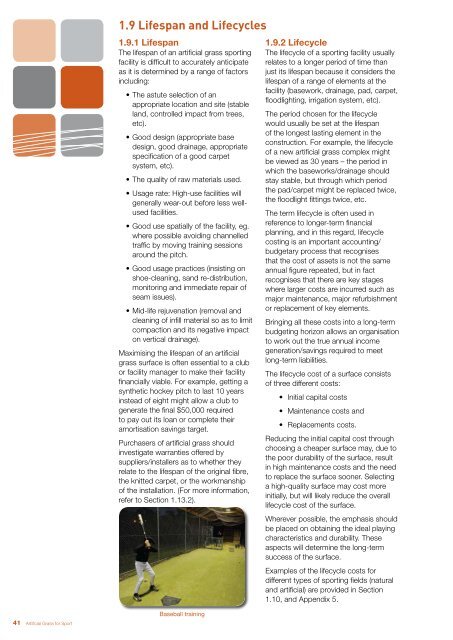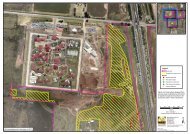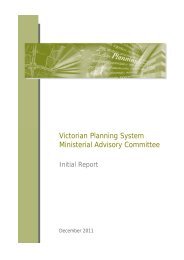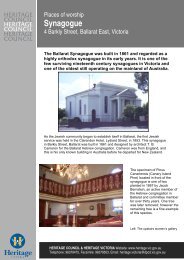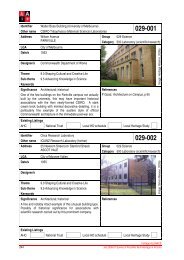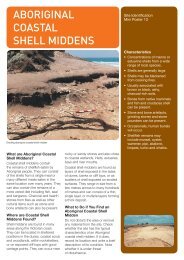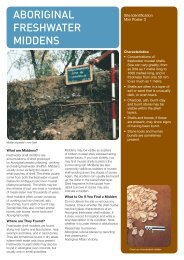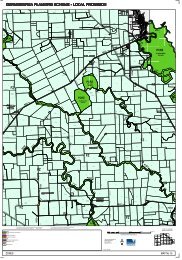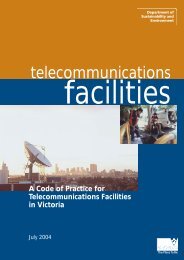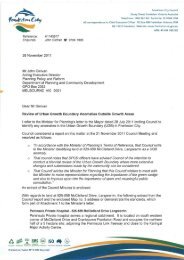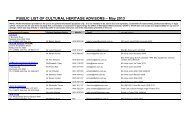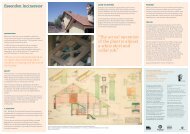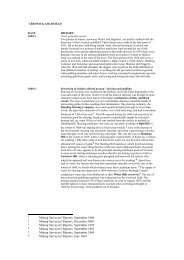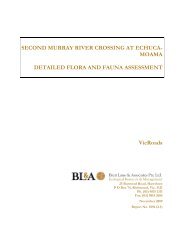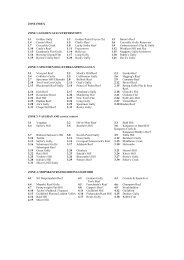Artificial Grass For Sport - Department of Planning and Community ...
Artificial Grass For Sport - Department of Planning and Community ...
Artificial Grass For Sport - Department of Planning and Community ...
You also want an ePaper? Increase the reach of your titles
YUMPU automatically turns print PDFs into web optimized ePapers that Google loves.
41<br />
<strong>Artificial</strong> <strong>Grass</strong> for <strong>Sport</strong><br />
1.9 Lifespan <strong>and</strong> Lifecycles<br />
1.9.1 Lifespan<br />
The lifespan <strong>of</strong> an artificial grass sporting<br />
facility is difficult to accurately anticipate<br />
as it is determined by a range <strong>of</strong> factors<br />
including:<br />
• The astute selection <strong>of</strong> an<br />
appropriate location <strong>and</strong> site (stable<br />
l<strong>and</strong>, controlled impact from trees,<br />
etc).<br />
• Good design (appropriate base<br />
design, good drainage, appropriate<br />
specification <strong>of</strong> a good carpet<br />
system, etc).<br />
• The quality <strong>of</strong> raw materials used.<br />
• Usage rate: High-use facilities will<br />
generally wear-out before less wellused<br />
facilities.<br />
• Good use spatially <strong>of</strong> the facility, eg.<br />
where possible avoiding channelled<br />
traffic by moving training sessions<br />
around the pitch.<br />
• Good usage practices (insisting on<br />
shoe-cleaning, s<strong>and</strong> re-distribution,<br />
monitoring <strong>and</strong> immediate repair <strong>of</strong><br />
seam issues).<br />
• Mid-life rejuvenation (removal <strong>and</strong><br />
cleaning <strong>of</strong> infill material so as to limit<br />
compaction <strong>and</strong> its negative impact<br />
on vertical drainage).<br />
Maximising the lifespan <strong>of</strong> an artificial<br />
grass surface is <strong>of</strong>ten essential to a club<br />
or facility manager to make their facility<br />
financially viable. <strong>For</strong> example, getting a<br />
synthetic hockey pitch to last 10 years<br />
instead <strong>of</strong> eight might allow a club to<br />
generate the final $50,000 required<br />
to pay out its loan or complete their<br />
amortisation savings target.<br />
Purchasers <strong>of</strong> artificial grass should<br />
investigate warranties <strong>of</strong>fered by<br />
suppliers/installers as to whether they<br />
relate to the lifespan <strong>of</strong> the original fibre,<br />
the knitted carpet, or the workmanship<br />
<strong>of</strong> the installation. (<strong>For</strong> more information,<br />
refer to Section 1.13.2).<br />
Baseball training<br />
1.9.2 Lifecycle<br />
The lifecycle <strong>of</strong> a sporting facility usually<br />
relates to a longer period <strong>of</strong> time than<br />
just its lifespan because it considers the<br />
lifespan <strong>of</strong> a range <strong>of</strong> elements at the<br />
facility (basework, drainage, pad, carpet,<br />
floodlighting, irrigation system, etc).<br />
The period chosen for the lifecycle<br />
would usually be set at the lifespan<br />
<strong>of</strong> the longest lasting element in the<br />
construction. <strong>For</strong> example, the lifecycle<br />
<strong>of</strong> a new artificial grass complex might<br />
be viewed as 30 years – the period in<br />
which the baseworks/drainage should<br />
stay stable, but through which period<br />
the pad/carpet might be replaced twice,<br />
the floodlight fittings twice, etc.<br />
The term lifecycle is <strong>of</strong>ten used in<br />
reference to longer-term financial<br />
planning, <strong>and</strong> in this regard, lifecycle<br />
costing is an important accounting/<br />
budgetary process that recognises<br />
that the cost <strong>of</strong> assets is not the same<br />
annual figure repeated, but in fact<br />
recognises that there are key stages<br />
where larger costs are incurred such as<br />
major maintenance, major refurbishment<br />
or replacement <strong>of</strong> key elements.<br />
Bringing all these costs into a long-term<br />
budgeting horizon allows an organisation<br />
to work out the true annual income<br />
generation/savings required to meet<br />
long-term liabilities.<br />
The lifecycle cost <strong>of</strong> a surface consists<br />
<strong>of</strong> three different costs:<br />
•<br />
•<br />
•<br />
Initial capital costs<br />
Maintenance costs <strong>and</strong><br />
Replacements costs.<br />
Reducing the initial capital cost through<br />
choosing a cheaper surface may, due to<br />
the poor durability <strong>of</strong> the surface, result<br />
in high maintenance costs <strong>and</strong> the need<br />
to replace the surface sooner. Selecting<br />
a high-quality surface may cost more<br />
initially, but will likely reduce the overall<br />
lifecycle cost <strong>of</strong> the surface.<br />
Wherever possible, the emphasis should<br />
be placed on obtaining the ideal playing<br />
characteristics <strong>and</strong> durability. These<br />
aspects will determine the long-term<br />
success <strong>of</strong> the surface.<br />
Examples <strong>of</strong> the lifecycle costs for<br />
different types <strong>of</strong> sporting fields (natural<br />
<strong>and</strong> artificial) are provided in Section<br />
1.10, <strong>and</strong> Appendix 5.


